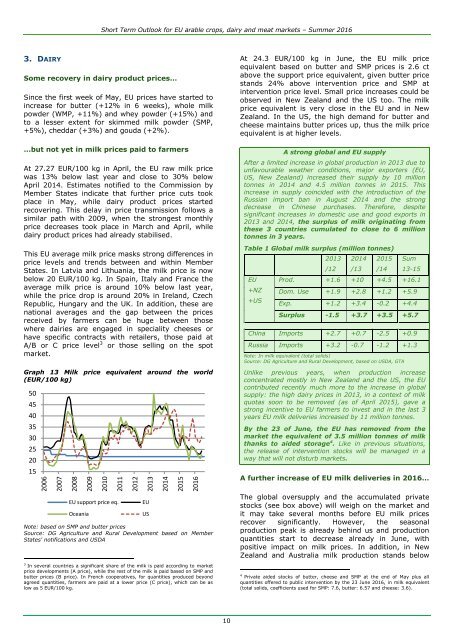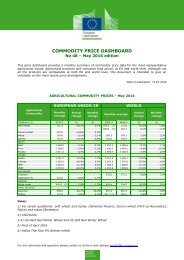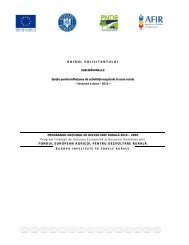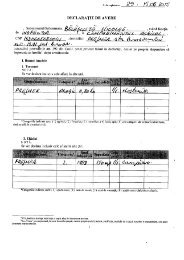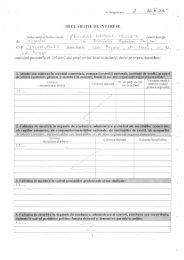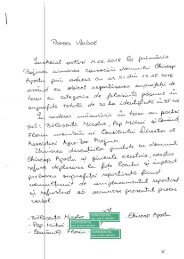You also want an ePaper? Increase the reach of your titles
YUMPU automatically turns print PDFs into web optimized ePapers that Google loves.
2006<br />
2007<br />
2008<br />
2009<br />
2010<br />
2011<br />
2012<br />
2013<br />
2014<br />
2015<br />
<strong>2016</strong><br />
Short Term Outlook for EU arable crops, dairy and meat markets – Summer <strong>2016</strong><br />
3. DAIRY<br />
Some recovery in dairy product prices…<br />
Since the first week of May, EU prices have started to<br />
increase for butter (+12% in 6 weeks), whole milk<br />
powder (WMP, +11%) and whey powder (+15%) and<br />
to a lesser ext<strong>en</strong>t for skimmed milk powder (SMP,<br />
+5%), cheddar (+3%) and gouda (+2%).<br />
…but not yet in milk prices paid to farmers<br />
At 27.27 EUR/100 kg in April, the EU raw milk price<br />
was 13% below last year and close to 30% below<br />
April 2014. Estimates notified to the Commission by<br />
Member States indicate that further price cuts took<br />
place in May, while dairy product prices started<br />
recovering. This delay in price transmission follows a<br />
similar path with 2009, wh<strong>en</strong> the strongest monthly<br />
price decreases took place in March and April, while<br />
dairy product prices had already stabilised.<br />
This EU average milk price masks strong differ<strong>en</strong>ces in<br />
price levels and tr<strong>en</strong>ds betwe<strong>en</strong> and within Member<br />
States. In Latvia and Lithuania, the milk price is now<br />
below 20 EUR/100 kg. In Spain, Italy and France the<br />
average milk price is around 10% below last year,<br />
while the price drop is around 20% in Ireland, Czech<br />
Republic, Hungary and the UK. In addition, these are<br />
national averages and the gap betwe<strong>en</strong> the prices<br />
received by farmers can be huge betwe<strong>en</strong> those<br />
where dairies are <strong>en</strong>gaged in speciality cheeses or<br />
have specific contracts with retailers, those paid at<br />
A/B or C price level 3 or those selling on the spot<br />
market.<br />
Graph 13 Milk price equival<strong>en</strong>t around the world<br />
(EUR/100 kg)<br />
50<br />
45<br />
40<br />
35<br />
30<br />
25<br />
20<br />
15<br />
At 24.3 EUR/100 kg in June, the EU milk price<br />
equival<strong>en</strong>t based on butter and SMP prices is 2.6 ct<br />
above the support price equival<strong>en</strong>t, giv<strong>en</strong> butter price<br />
stands 24% above interv<strong>en</strong>tion price and SMP at<br />
interv<strong>en</strong>tion price level. Small price increases could be<br />
observed in New Zealand and the US too. The milk<br />
price equival<strong>en</strong>t is very close in the EU and in New<br />
Zealand. In the US, the high demand for butter and<br />
cheese maintains butter prices up, thus the milk price<br />
equival<strong>en</strong>t is at higher levels.<br />
A strong global and EU supply<br />
After a limited increase in global production in 2013 due to<br />
unfavourable weather conditions, major exporters (EU,<br />
US, New Zealand) increased their supply by 10 million<br />
tonnes in 2014 and 4.5 million tonnes in 2015. This<br />
increase in supply coincided with the introduction of the<br />
Russian import ban in August 2014 and the strong<br />
decrease in Chinese purchases. Therefore, despite<br />
significant increases in domestic use and good exports in<br />
2013 and 2014, the surplus of milk originating from<br />
these 3 countries cumulated to close to 6 million<br />
tonnes in 3 years.<br />
Table 1 Global milk surplus (million tonnes)<br />
EU<br />
+NZ<br />
+US<br />
2013<br />
/12<br />
2014<br />
/13<br />
2015<br />
/14<br />
Sum<br />
13-15<br />
Prod. +1.6 +10 +4.5 +16.1<br />
Dom. Use +1.9 +2.8 +1.2 +5.9<br />
Exp. +1.2 +3.4 -0.2 +4.4<br />
Surplus -1.5 +3.7 +3.5 +5.7<br />
China Imports +2.7 +0.7 -2.5 +0.9<br />
Russia Imports +3.2 -0.7 -1.2 +1.3<br />
Note: In milk equival<strong>en</strong>t (total solids)<br />
Source: DG Agriculture and Rural Developm<strong>en</strong>t, based on USDA, GTA<br />
Unlike previous years, wh<strong>en</strong> production increase<br />
conc<strong>en</strong>trated mostly in New Zealand and the US, the EU<br />
contributed rec<strong>en</strong>tly much more to the increase in global<br />
supply: the high dairy prices in 2013, in a context of milk<br />
quotas soon to be removed (as of April 2015), gave a<br />
strong inc<strong>en</strong>tive to EU farmers to invest and in the last 3<br />
years EU milk deliveries increased by 11 million tonnes.<br />
By the 23 of June, the EU has removed from the<br />
market the equival<strong>en</strong>t of 3.5 million tonnes of milk<br />
thanks to aided storage 4 . Like in previous situations,<br />
the release of interv<strong>en</strong>tion stocks will be managed in a<br />
way that will not disturb markets.<br />
A further increase of EU milk deliveries in <strong>2016</strong>…<br />
EU support price eq.<br />
Oceania<br />
Note: based on SMP and butter prices<br />
Source: DG Agriculture and Rural Developm<strong>en</strong>t based on Member<br />
States' notifications and USDA<br />
3<br />
In several countries a significant share of the milk is paid according to market<br />
price developm<strong>en</strong>ts (A price), while the rest of the milk is paid based on SMP and<br />
butter prices (B price). In Fr<strong>en</strong>ch cooperatives, for quantities produced beyond<br />
agreed quantities, farmers are paid at a lower price (C price), which can be as<br />
low as 5 EUR/100 kg.<br />
EU<br />
US<br />
The global oversupply and the accumulated private<br />
stocks (see box above) will weigh on the market and<br />
it may take several months before EU milk prices<br />
recover significantly. However, the seasonal<br />
production peak is already behind us and production<br />
quantities start to decrease already in June, with<br />
positive impact on milk prices. In addition, in New<br />
Zealand and Australia milk production stands below<br />
4<br />
Private aided stocks of butter, cheese and SMP at the <strong>en</strong>d of May plus all<br />
quantities offered to public interv<strong>en</strong>tion by the 23 June <strong>2016</strong>, in milk equival<strong>en</strong>t<br />
(total solids, coeffici<strong>en</strong>ts used for SMP: 7.6, butter: 6.57 and cheese: 3.6).<br />
10


